Lancia Musa 2009 Owner handbook (in English)
Manufacturer: LANCIA, Model Year: 2009, Model line: Musa, Model: Lancia Musa 2009Pages: 218, PDF Size: 3.7 MB
Page 111 of 218

110
STARTING
AND
DRIVING
WARNING
LIGHTS AND
MESSAGES
IN AN
EMERGENCY
MAINTENANCE
AND CARE
TECHNICALSPECIFICATIONS
INDEX
DASHBOARD
AND CONTROLS
SAFETY
DEVICES
MANUAL DEACTIVATION OF
FRONT AIRBAG AND SIDE BAG
ON PASSENGER’S SIDE
(where provided)
Whenever a child needs to be carried
on the front seat, the passenger’s front
airbag and the Side Bag (where pro-
vided) must be deactivated.
The warning light “on the instru-
ment panel stays on steadily until the
passenger’s front airbag and the Side
Bag (where provided) are re-acti-
vated.SIDE BAGS
(window bag)
(where provided)
SIDE BAG (where provided) fig.
19
It consists of an instant-inflating bag
housed in the front seat backrest. It
protects the chest of the passengers in
the event of a side crash of medium-
high severity.
To manually deactivate the
passenger’s front airbag and
the Side Bag (where provided), re-
fer to paragraph “Multifunctional
reconfigurable display” in section
“Dashboard and controls”.
WARNING
Do not cover the front seat
backrest with upholstery or
seat covers that hinder deployment
of the side bag.
WARNING
fig. 19L0C0147m
fig. 20L0C0148m
WINDOW BAG
(where provided) fig. 20
It consists of two “drop-down” bags
housed behind the side upholstery of
the roof and covered with finishing el-
ements that protect the head of front
and rear passengers in the event of a
side crash thanks to a wide bag de-
ployment area. Lineaccessori Lancia includes seat
covers enabling side bag deployment.
095-112 MUSA 1ed GB 10-07-2008 9:37 Pagina 110
Page 112 of 218

111
STARTING
AND
DRIVING
WARNING
LIGHTS AND
MESSAGES
IN AN
EMERGENCY
MAINTENANCE
AND CARE
TECHNICALSPECIFICATIONS
INDEX
DASHBOARD
AND CONTROLS
SAFETY
DEVICES
Side bags are not a replacement of,
but complementary to the seat belts,
which you are always recommended
to wear, as specified by law in Europe
and in most non-European countries.
IMPORTANT In the event of a side
crash, the system provides best pro-
tection if the passenger sits on the seat
in a correct position, thus allowing
correct window bag deployment.
IMPORTANT The front airbags
and/or side bags are deployed also if
the car is subject to strong collisions
or accidents involving the underbody
area, such as violent shocks against
steps, kerbs or low obstacles, falling
of the car in big holes or sags in the
road.
IMPORTANT A small amount of dust
is released when the airbags are de-
ployed. The dust is not harmful and
does not indicate the beginning of a
fire. Furthermore, the surface of the
deployed bag and the interior of the
car may be covered with residual
dust. This dust may irritate the skin
and the eyes. Use mild soap and wa-
ter to wash the parts of your body ex-
posed to this dust.The pyrotechnic charge of the airbag
system lasts for 14 years; the spiral
contact 10 years. Go to a Lancia
Dealership to have the devices re-
placed when the expiration date ap-
proaches.
IMPORTANT Should an accident oc-
cur activating any of the safety de-
vices, take the car to a Lancia Deal-
ership to have the activated devices
replaced and the system checked.
Airbag checking, repair and replace-
ment must only be carried out c/o the
Lancia Dealership.
If you are having the car scrapped,
have the airbag system deactivated at
a Lancia Dealership first. If the car
changes ownership, the new owner
must be informed of how to use the
airbags and the above warnings: s/he
must also be given this “Owner’s
Handbook”.
IMPORTANT Pretensioners, front
airbags and front side bags are de-
ployed differently according to the
type of collision. Non-deployment of
one of the devices does not necessar-
ily indicate a system malfunction.
Do not rest the head, arms
or elbows on the door, win-
dows and window bag area to avoid
possible injuries during inflation.
Never lean head, arms and elbows
out of the window.
WARNING
If the warning light ¬does
not turn on or stays on dur-
ing car travel when turning the key
to MAR, a failure may be present in
the restraint systems. If this is the
case, the airbags or pretensioners
may not be deployed after an impact
or, in a minor number of cases, they
may be deployed accidentally. Con-
tact a Lancia Dealership immedi-
ately to have the system checked.
Do not cover the front seat backrest
with upholstery or seat covers that
hinder deployment of the side bag.
WARNING
GENERAL WARNINGS
095-112 MUSA 1ed GB 10-07-2008 9:37 Pagina 111
Page 113 of 218
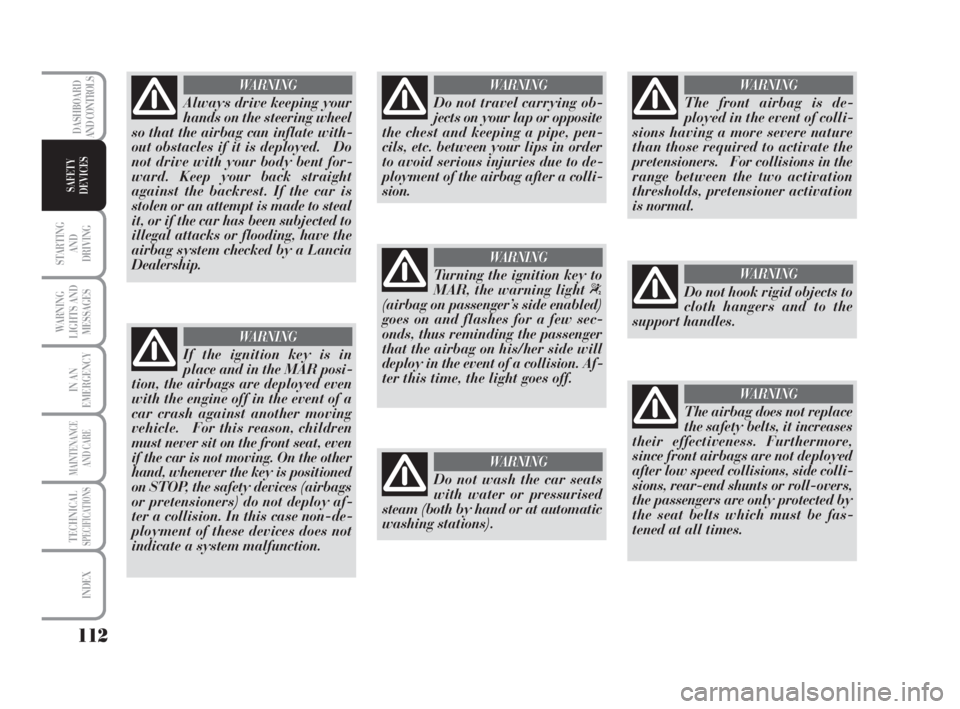
112
STARTING
AND
DRIVING
WARNING
LIGHTS AND
MESSAGES
IN AN
EMERGENCY
MAINTENANCE
AND CARE
TECHNICALSPECIFICATIONS
INDEX
DASHBOARD
AND CONTROLS
SAFETY
DEVICES
Always drive keeping your
hands on the steering wheel
so that the airbag can inflate with-
out obstacles if it is deployed. Do
not drive with your body bent for-
ward. Keep your back straight
against the backrest. If the car is
stolen or an attempt is made to steal
it, or if the car has been subjected to
illegal attacks or flooding, have the
airbag system checked by a Lancia
Dealership.
WARNING
Do not travel carrying ob-
jects on your lap or opposite
the chest and keeping a pipe, pen-
cils, etc. between your lips in order
to avoid serious injuries due to de-
ployment of the airbag after a colli-
sion.
WARNING
The front airbag is de-
ployed in the event of colli-
sions having a more severe nature
than those required to activate the
pretensioners. For collisions in the
range between the two activation
thresholds, pretensioner activation
is normal.
WARNING
Turning the ignition key to
MAR, the warning light “
(airbag on passenger’s side enabled)
goes on and flashes for a few sec-
onds, thus reminding the passenger
that the airbag on his/her side will
deploy in the event of a collision. Af-
ter this time, the light goes off.
WARNING
Do not wash the car seats
with water or pressurised
steam (both by hand or at automatic
washing stations).
WARNING
The airbag does not replace
the safety belts, it increases
their effectiveness. Furthermore,
since front airbags are not deployed
after low speed collisions, side colli-
sions, rear-end shunts or roll-overs,
the passengers are only protected by
the seat belts which must be fas-
tened at all times.
WARNING
Do not hook rigid objects to
cloth hangers and to the
support handles.
WARNING
If the ignition key is in
place and in the MAR posi-
tion, the airbags are deployed even
with the engine off in the event of a
car crash against another moving
vehicle. For this reason, children
must never sit on the front seat, even
if the car is not moving. On the other
hand, whenever the key is positioned
on STOP, the safety devices (airbags
or pretensioners) do not deploy af-
ter a collision. In this case non-de-
ployment of these devices does not
indicate a system malfunction.
WARNING
095-112 MUSA 1ed GB 10-07-2008 9:37 Pagina 112
Page 114 of 218
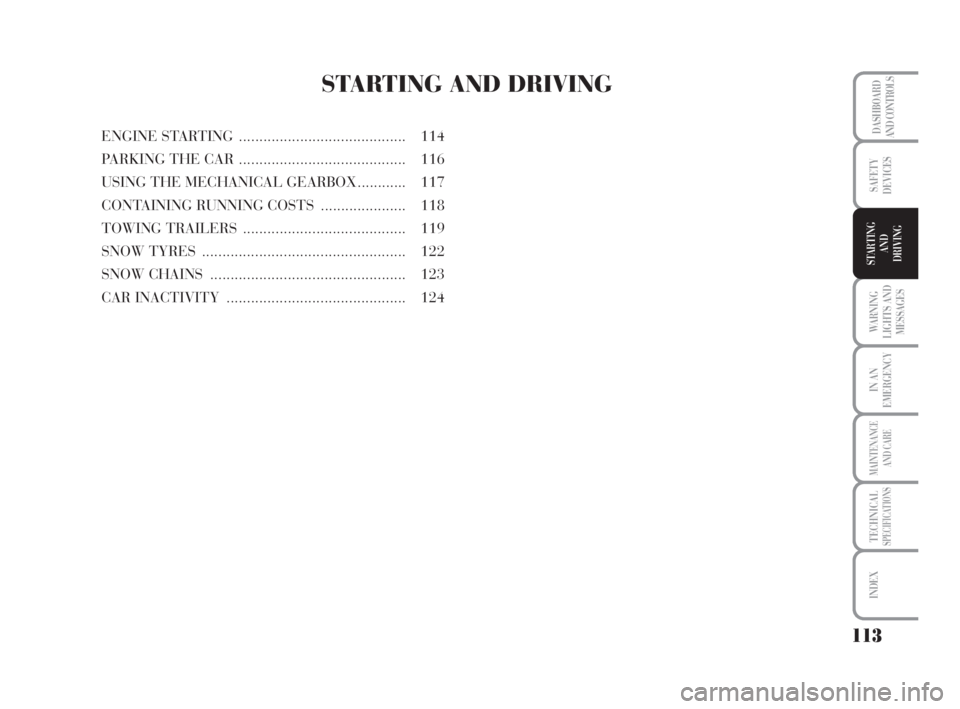
113
WARNING
LIGHTS AND
MESSAGES
IN AN
EMERGENCY
MAINTENANCE
AND CARE
TECHNICALSPECIFICATIONS
INDEX
DASHBOARD
AND CONTROLS
SAFETY
DEVICES
STARTING
AND
DRIVING
STARTING AND DRIVING
ENGINE STARTING ......................................... 114
PARKING THE CAR ......................................... 116
USING THE MECHANICAL GEARBOX............117
CONTAINING RUNNING COSTS ..................... 118
TOWING TRAILERS ........................................ 119
SNOW TYRES .................................................. 122
SNOW CHAINS ................................................ 123
CAR INACTIVITY ............................................ 124
113-124 MUSA 1ed GB 10-07-2008 9:37 Pagina 113
Page 115 of 218
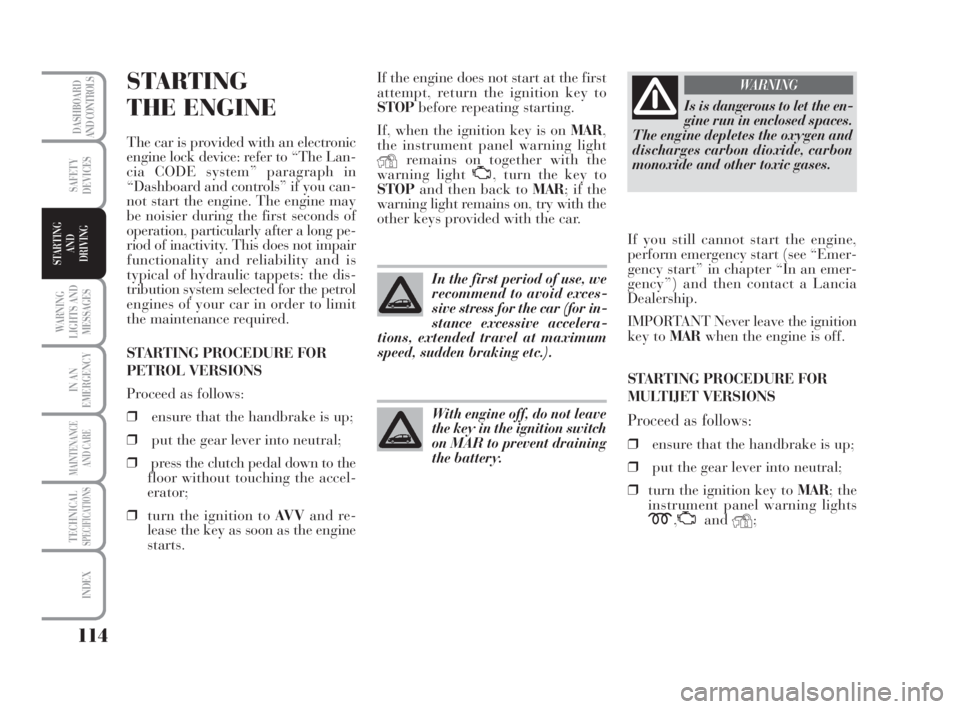
114
WARNING
LIGHTS AND
MESSAGES
IN AN
EMERGENCY
MAINTENANCE
AND CARE
TECHNICALSPECIFICATIONS
INDEX
DASHBOARD
AND CONTROLS
SAFETY
DEVICES
STARTING
AND
DRIVING
STARTING
THE ENGINE
The car is provided with an electronic
engine lock device: refer to “The Lan-
cia CODE system” paragraph in
“Dashboard and controls” if you can-
not start the engine. The engine may
be noisier during the first seconds of
operation, particularly after a long pe-
riod of inactivity. This does not impair
functionality and reliability and is
typical of hydraulic tappets: the dis-
tribution system selected for the petrol
engines of your car in order to limit
the maintenance required.
STARTING PROCEDURE FOR
PETROL VERSIONS
Proceed as follows:
❒ensure that the handbrake is up;
❒put the gear lever into neutral;
❒press the clutch pedal down to the
floor without touching the accel-
erator;
❒turn the ignition to AV Vand re-
lease the key as soon as the engine
starts.If the engine does not start at the first
attempt, return the ignition key to
STOPbefore repeating starting.
If, when the ignition key is on MAR,
the instrument panel warning light
Yremains on together with the
warning light U, turn the key to
STOPand then back to MAR; if the
warning light remains on, try with the
other keys provided with the car.
Is is dangerous to let the en-
gine run in enclosed spaces.
The engine depletes the oxygen and
discharges carbon dioxide, carbon
monoxide and other toxic gases.
WARNING
In the first period of use, we
recommend to avoid exces-
sive stress for the car (for in-
stance excessive accelera-
tions, extended travel at maximum
speed, sudden braking etc.).
With engine off, do not leave
the key in the ignition switch
on MAR to prevent draining
the battery.
If you still cannot start the engine,
perform emergency start (see “Emer-
gency start” in chapter “In an emer-
gency”) and then contact a Lancia
Dealership.
IMPORTANT Never leave the ignition
key to MARwhen the engine is off.
STARTING PROCEDURE FOR
MULTIJET VERSIONS
Proceed as follows:
❒ensure that the handbrake is up;
❒put the gear lever into neutral;
❒turn the ignition key to MAR; the
instrument panel warning lights
m,
UandY;
113-124 MUSA 1ed GB 10-07-2008 9:37 Pagina 114
Page 116 of 218
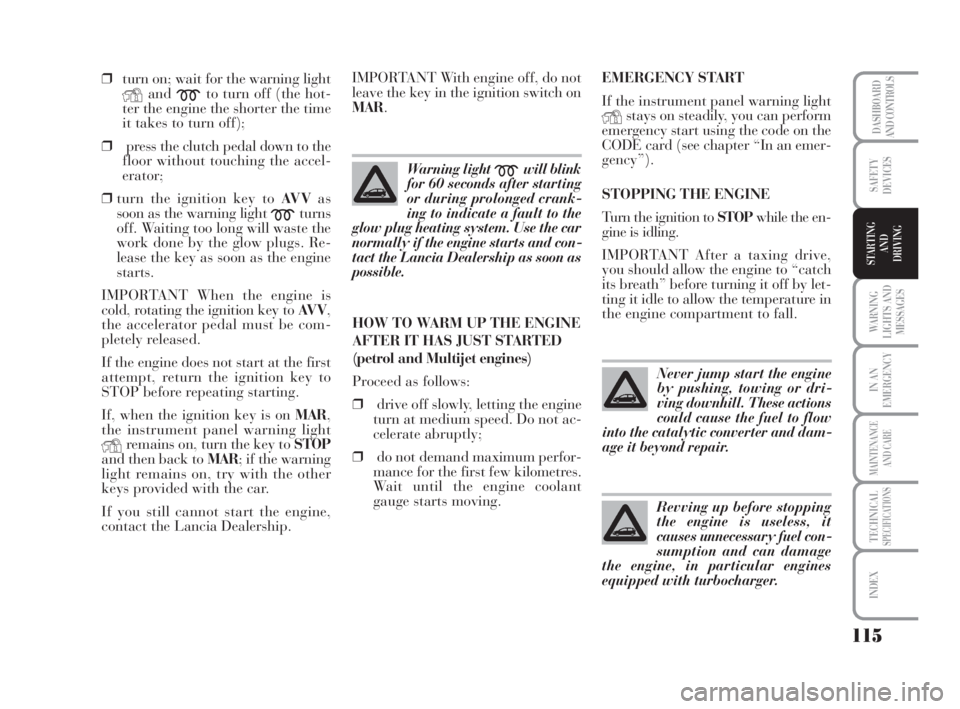
115
WARNING
LIGHTS AND
MESSAGES
IN AN
EMERGENCY
MAINTENANCE
AND CARE
TECHNICALSPECIFICATIONS
INDEX
DASHBOARD
AND CONTROLS
SAFETY
DEVICES
STARTING
AND
DRIVING
❒turn on; wait for the warning light
Yand
mto turn off (the hot-
ter the engine the shorter the time
it takes to turn off);
❒press the clutch pedal down to the
floor without touching the accel-
erator;
❒turn the ignition key to AV Vas
soon as the warning light
mturns
off. Waiting too long will waste the
work done by the glow plugs. Re-
lease the key as soon as the engine
starts.
IMPORTANT When the engine is
cold, rotating the ignition key to AV V,
the accelerator pedal must be com-
pletely released.
If the engine does not start at the first
attempt, return the ignition key to
STOP before repeating starting.
If, when the ignition key is on MAR,
the instrument panel warning light
Yremains on, turn the key to STOP
and then back to MAR; if the warning
light remains on, try with the other
keys provided with the car.
If you still cannot start the engine,
contact the Lancia Dealership.HOW TO WARM UP THE ENGINE
AFTER IT HAS JUST STARTED
(petrol and Multijet engines)
Proceed as follows:
❒drive off slowly, letting the engine
turn at medium speed. Do not ac-
celerate abruptly;
❒do not demand maximum perfor-
mance for the first few kilometres.
Wait until the engine coolant
gauge starts moving.Warning light
mwill blink
for 60 seconds after starting
or during prolonged crank-
ing to indicate a fault to the
glow plug heating system. Use the car
normally if the engine starts and con-
tact the Lancia Dealership as soon as
possible.
EMERGENCY START
If the instrument panel warning light
Ystays on steadily, you can perform
emergency start using the code on the
CODE card (see chapter “In an emer-
gency”).
STOPPING THE ENGINE
Turn the ignition to STOPwhile the en-
gine is idling.
IMPORTANT After a taxing drive,
you should allow the engine to “catch
its breath” before turning it off by let-
ting it idle to allow the temperature in
the engine compartment to fall.
Never jump start the engine
by pushing, towing or dri-
ving downhill. These actions
could cause the fuel to flow
into the catalytic converter and dam-
age it beyond repair.
Revving up before stopping
the engine is useless, it
causes unnecessary fuel con-
sumption and can damage
the engine, in particular engines
equipped with turbocharger.
IMPORTANT With engine off, do not
leave the key in the ignition switch on
MAR.
113-124 MUSA 1ed GB 10-07-2008 9:37 Pagina 115
Page 117 of 218
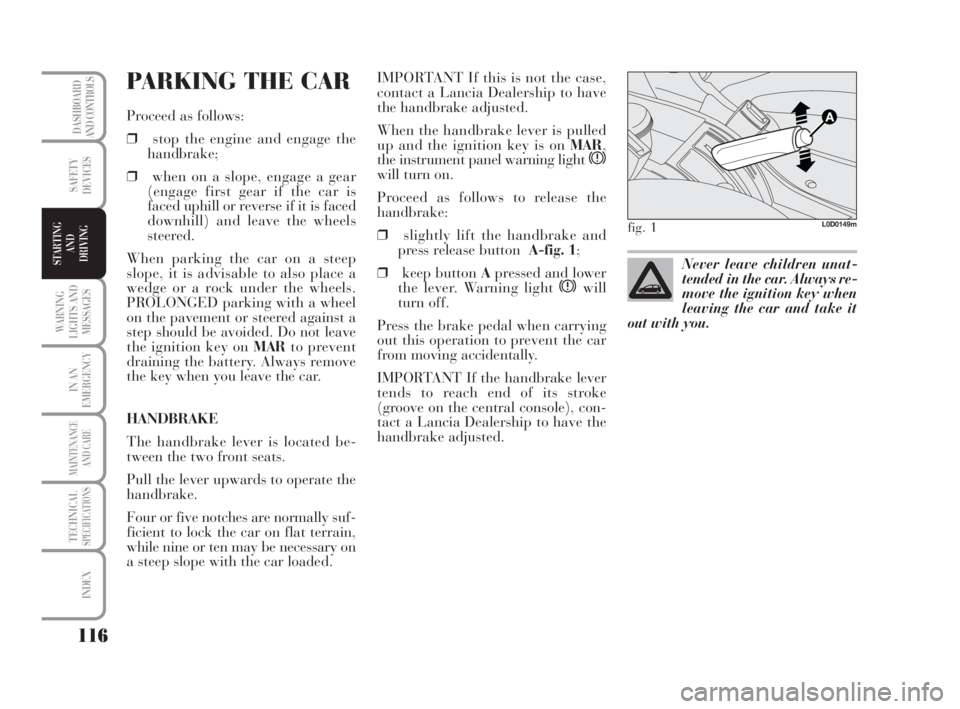
116
WARNING
LIGHTS AND
MESSAGES
IN AN
EMERGENCY
MAINTENANCE
AND CARE
TECHNICALSPECIFICATIONS
INDEX
DASHBOARD
AND CONTROLS
SAFETY
DEVICES
STARTING
AND
DRIVING
PARKING THE CAR
Proceed as follows:
❒stop the engine and engage the
handbrake;
❒when on a slope, engage a gear
(engage first gear if the car is
faced uphill or reverse if it is faced
downhill) and leave the wheels
steered.
When parking the car on a steep
slope, it is advisable to also place a
wedge or a rock under the wheels.
PROLONGED parking with a wheel
on the pavement or steered against a
step should be avoided. Do not leave
the ignition key on MARto prevent
draining the battery. Always remove
the key when you leave the car.
HANDBRAKE
The handbrake lever is located be-
tween the two front seats.
Pull the lever upwards to operate the
handbrake.
Four or five notches are normally suf-
ficient to lock the car on flat terrain,
while nine or ten may be necessary on
a steep slope with the car loaded. IMPORTANT If this is not the case,
contact a Lancia Dealership to have
the handbrake adjusted.
When the handbrake lever is pulled
up and the ignition key is on MAR,
the instrument panel warning light
xwill turn on.
Proceed as follows to release the
handbrake:
❒slightly lift the handbrake and
press release button A-fig. 1;
❒keep button Apressed and lower
the lever. Warning light
xwill
turn off.
Press the brake pedal when carrying
out this operation to prevent the car
from moving accidentally.
IMPORTANT If the handbrake lever
tends to reach end of its stroke
(groove on the central console), con-
tact a Lancia Dealership to have the
handbrake adjusted.
fig. 1L0D0149m
Never leave children unat-
tended in the car. Always re-
move the ignition key when
leaving the car and take it
out with you.
113-124 MUSA 1ed GB 10-07-2008 9:37 Pagina 116
Page 118 of 218

117
WARNING
LIGHTS AND
MESSAGES
IN AN
EMERGENCY
MAINTENANCE
AND CARE
TECHNICALSPECIFICATIONS
INDEX
DASHBOARD
AND CONTROLS
SAFETY
DEVICES
STARTING
AND
DRIVING
USING THE
MECHANICAL
GEARBOX
To engage the gears, press the clutch
pedal fully and shift the gear lever
into one of the required positions (the
diagram is shown on the knob).
IMPORTANT Reverse may only be
engaged when the car is at a stand-
still. With the engine running, wait for
at least 2 seconds with the clutch
pedal fully pressed before engaging
reverse to prevent damage to the gears
and grating.
To engage sixth gear (where pro-
vided), operate the lever by pressing
it towards the right in order to avoid
engaging fourth gear by mistake. The
same applies when shifting from sixth
to fifth gear.
To engage reverse Rfrom neutral, lift
the sliding collar A-fig. 2-3 under the
knob while shifting the lever towards
the right and then backwards (only
for petrol versions).
For Multijet versions, only shift the
lever towards the right and then back-
wards.
fig. 2L0D0150m
fig. 3L0D0360m
Do not drive with the hand
resting on the gear lever, be-
cause this pressure, even if
light, over time can wear
gear inner components.
Press the clutch pedal fully
to change gears correctly.
For this reason, there must be no
obstacles on the floor under the ped-
als: ensure that rubber mats (if any)
are correctly positioned, not inter-
fering with the pedals.
WARNING
113-124 MUSA 1ed GB 10-07-2008 9:37 Pagina 117
Page 119 of 218
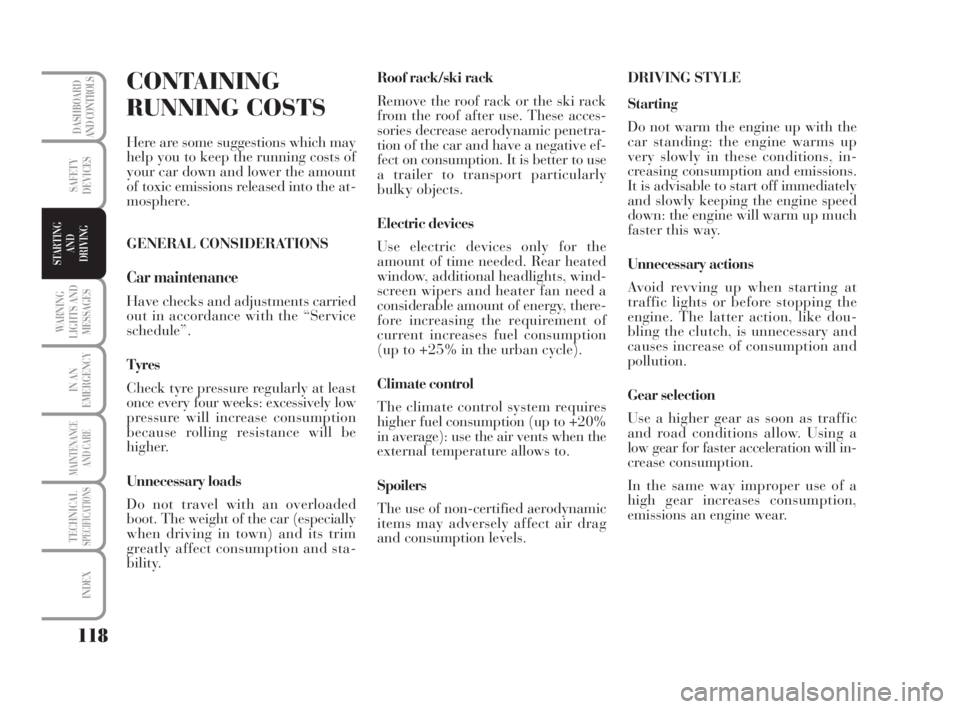
118
WARNING
LIGHTS AND
MESSAGES
IN AN
EMERGENCY
MAINTENANCE
AND CARE
TECHNICALSPECIFICATIONS
INDEX
DASHBOARD
AND CONTROLS
SAFETY
DEVICES
STARTING
AND
DRIVING
CONTAINING
RUNNING COSTS
Here are some suggestions which may
help you to keep the running costs of
your car down and lower the amount
of toxic emissions released into the at-
mosphere.
GENERAL CONSIDERATIONS
Car maintenance
Have checks and adjustments carried
out in accordance with the “Service
schedule”.
Tyres
Check tyre pressure regularly at least
once every four weeks: excessively low
pressure will increase consumption
because rolling resistance will be
higher.
Unnecessary loads
Do not travel with an overloaded
boot. The weight of the car (especially
when driving in town) and its trim
greatly affect consumption and sta-
bility.Roof rack/ski rack
Remove the roof rack or the ski rack
from the roof after use. These acces-
sories decrease aerodynamic penetra-
tion of the car and have a negative ef-
fect on consumption. It is better to use
a trailer to transport particularly
bulky objects.
Electric devices
Use electric devices only for the
amount of time needed. Rear heated
window, additional headlights, wind-
screen wipers and heater fan need a
considerable amount of energy, there-
fore increasing the requirement of
current increases fuel consumption
(up to +25% in the urban cycle).
Climate control
The climate control system requires
higher fuel consumption (up to +20%
in average): use the air vents when the
external temperature allows to.
Spoilers
The use of non-certified aerodynamic
items may adversely affect air drag
and consumption levels.DRIVING STYLE
Starting
Do not warm the engine up with the
car standing: the engine warms up
very slowly in these conditions, in-
creasing consumption and emissions.
It is advisable to start off immediately
and slowly keeping the engine speed
down: the engine will warm up much
faster this way.
Unnecessary actions
Avoid revving up when starting at
traffic lights or before stopping the
engine. The latter action, like dou-
bling the clutch, is unnecessary and
causes increase of consumption and
pollution.
Gear selection
Use a higher gear as soon as traffic
and road conditions allow. Using a
low gear for faster acceleration will in-
crease consumption.
In the same way improper use of a
high gear increases consumption,
emissions an engine wear.
113-124 MUSA 1ed GB 10-07-2008 9:37 Pagina 118
Page 120 of 218
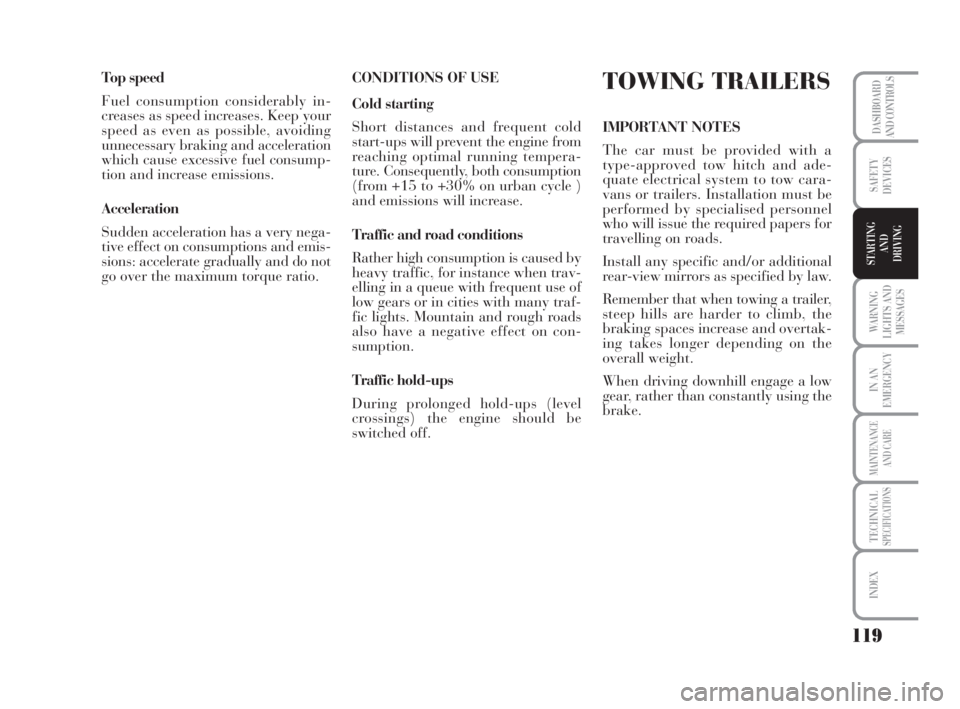
119
WARNING
LIGHTS AND
MESSAGES
IN AN
EMERGENCY
MAINTENANCE
AND CARE
TECHNICALSPECIFICATIONS
INDEX
DASHBOARD
AND CONTROLS
SAFETY
DEVICES
STARTING
AND
DRIVING
Top speed
Fuel consumption considerably in-
creases as speed increases. Keep your
speed as even as possible, avoiding
unnecessary braking and acceleration
which cause excessive fuel consump-
tion and increase emissions.
Acceleration
Sudden acceleration has a very nega-
tive effect on consumptions and emis-
sions: accelerate gradually and do not
go over the maximum torque ratio.CONDITIONS OF USE
Cold starting
Short distances and frequent cold
start-ups will prevent the engine from
reaching optimal running tempera-
ture. Consequently, both consumption
(from +15 to +30% on urban cycle )
and emissions will increase.
Traffic and road conditions
Rather high consumption is caused by
heavy traffic, for instance when trav-
elling in a queue with frequent use of
low gears or in cities with many traf-
fic lights. Mountain and rough roads
also have a negative effect on con-
sumption.
Traffic hold-ups
During prolonged hold-ups (level
crossings) the engine should be
switched off.TOWING TRAILERS
IMPORTANT NOTES
The car must be provided with a
type-approved tow hitch and ade-
quate electrical system to tow cara-
vans or trailers. Installation must be
performed by specialised personnel
who will issue the required papers for
travelling on roads.
Install any specific and/or additional
rear-view mirrors as specified by law.
Remember that when towing a trailer,
steep hills are harder to climb, the
braking spaces increase and overtak-
ing takes longer depending on the
overall weight.
When driving downhill engage a low
gear, rather than constantly using the
brake.
113-124 MUSA 1ed GB 10-07-2008 9:37 Pagina 119